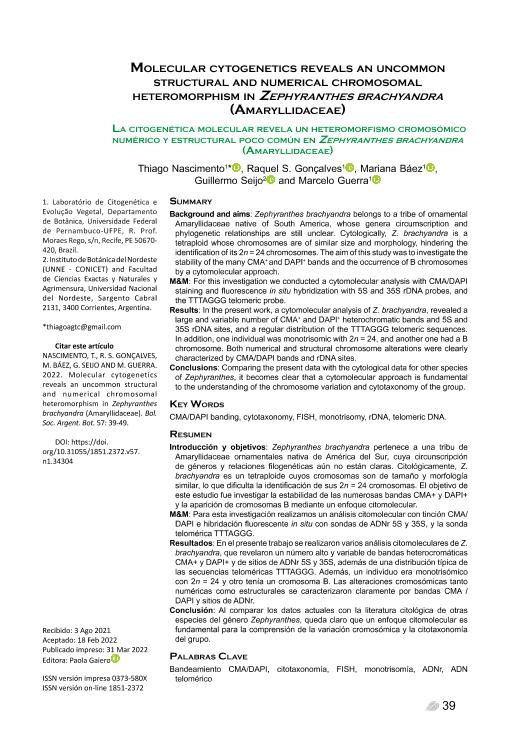Artículo
Background and aims: Zephyranthes brachyandra belongs to a tribe of ornamental Amaryllidaceae native of South America, whose genera circumscription and phylogenetic relationships are still unclear. Cytologically, Z. brachyandra is a tetraploid whose chromosomes are of similar size and morphology, hindering the identification of its 2n = 24 chromosomes. The aim of this study was to investigate the stability of the many CMA+ and DAPI+ bands and the occurrence of B chromosomes by a cytomolecular approach.M&M: For this investigation we conducted a cytomolecular analysis with CMA/DAPI staining and fluorescence in situ hybridization with 5S and 35S rDNA probes, and the TTTAGGG telomeric probe.Results: In the present work, a cytomolecular analysis of Z. brachyandra, revealed a large and variable number of CMA+ and DAPI+ heterochromatic bands and 5S and 35S rDNA sites, and a regular distribution of the TTTAGGG telomeric sequences. In addition, one individual was monotrisomic with 2n = 24, and another one had a B chromosome. Both numerical and structural chromosome alterations were clearly characterized by CMA/DAPI bands and rDNA sites.Conclusions: Comparing the present data with the cytological data for other species of Zephyranthes, it becomes clear that a cytomolecular approach is fundamental to the understanding of the chromosome variation and cytotaxonomy of the group. Introducción y objetivos: Zephyranthes brachyandra pertenece a una tribu de Amaryllidaceae ornamentales nativa de América del Sur, cuya circunscripción de géneros y relaciones filogenéticas aún no están claras. Citológicamente, Z. brachyandra es un tetraploide cuyos cromosomas son de tamaño y morfología similar, lo que dificulta la identificación de sus 2n = 24 cromosomas. El objetivo de este estudio fue investigar la estabilidad de las numerosas bandas CMA+ y DAPI+ y la aparición de cromosomas B mediante un enfoque citomolecular. M&M: Para esta investigación realizamos un análisis citomolecular con tinción CMA/ DAPI e hibridación fluorescente in situ con sondas de ADNr 5S y 35S, y la sonda telomérica TTTAGGG. Resultados: En el presente trabajo se realizaron varios análisis citomoleculares de Z. brachyandra, que revelaron un número alto y variable de bandas heterocromáticas CMA+ y DAPI+ y de sitios de ADNr 5S y 35S, además de una distribución típica de las secuencias teloméricas TTTAGGG. Además, un individuo era monotrisómico con 2n = 24 y otro tenía un cromosoma B. Las alteraciones cromosómicas tanto numéricas como estructurales se caracterizaron claramente por bandas CMA / DAPI y sitios de ADNr. Conclusión: Al comparar los datos actuales con la literatura citológica de otras especies del género Zephyranthes, queda claro que un enfoque citomolecular es fundamental para la comprensión de la variación cromosómica y la citotaxonomía del grupo.
Molecular cytogenetics reveals an uncommon structural and numerical chromosomal heteromorphism in Zephyranthes brachyandra (Amaryllidaceae)
Título:
La citogenética molecular revela un heteromorfismo cromosómico numérico y estructural poco común en Zephyranthes brachyandra (Amaryllidaceae)
Nascimento, Tiago; Baez, Jesica Mariana ; Gongalves, Raquel; Seijo, José Guillermo
; Gongalves, Raquel; Seijo, José Guillermo ; Guerra, Marcelo
; Guerra, Marcelo
 ; Gongalves, Raquel; Seijo, José Guillermo
; Gongalves, Raquel; Seijo, José Guillermo ; Guerra, Marcelo
; Guerra, Marcelo
Fecha de publicación:
08/2022
Editorial:
Sociedad Argentina de Botánica
Revista:
Boletín de la Sociedad Argentina de Botánica
ISSN:
0373-580X
e-ISSN:
1851-2372
Idioma:
Inglés
Tipo de recurso:
Artículo publicado
Clasificación temática:
Resumen
Palabras clave:
Chromosome
,
Amaryllidaceae
Archivos asociados
Licencia
Identificadores
Colecciones
Articulos(IBONE)
Articulos de INST.DE BOTANICA DEL NORDESTE (I)
Articulos de INST.DE BOTANICA DEL NORDESTE (I)
Citación
Nascimento, Tiago; Baez, Jesica Mariana; Gongalves, Raquel; Seijo, José Guillermo; Guerra, Marcelo; Molecular cytogenetics reveals an uncommon structural and numerical chromosomal heteromorphism in Zephyranthes brachyandra (Amaryllidaceae); Sociedad Argentina de Botánica; Boletín de la Sociedad Argentina de Botánica; 57; 1; 8-2022; 39-49
Compartir



